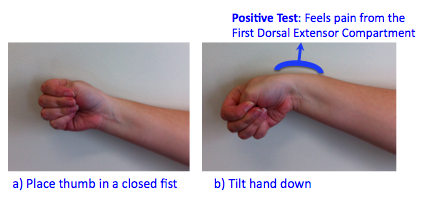In order to understand this condition, it is important to understand the anatomy and function of the wrist and hand. Please read Wrist Pain Info / Hand Pain Info’s sections on wrist anatomy and hand anatomy. For information on the biomechanics of the wrist and hand please read Wrist Pain Info / Hand Pain Info’s section on wrist and hand biomechanics. De Quervain Syndrome is also known as De Quervain’s Tenosynovitis.
What is De Quervain Syndrome?
De Quervain syndrome is the term used to describe irritation (inflammation) and swelling of the sheath or tunnel that surrounds these tendons. Tendons are “rope like” structures that connect muscles to bone. The abductor pollicis longus muscle and the extensor pollicis brevis muscle are two of the muscles that help move the thumb away from the fingers. These muscles are in the forearm. Their tendons cross the wrist and attach to the bone at the bottom of the thumb.
What does De Quervain Syndrome feel like?
De Quervain syndrome usually develops gradually. The pain from deQuervain’s syndrome is often localized to the wrist and the area at the bottom of the thumb. Pain is often felt in these areas when gripping or using the hand. If the hand is made into a fist with the thumb “tucked in” and bent towards the little finger, the pain is often made worse. There can also be swelling over the tendons.
What causes De Quervain Syndrome?
The exact cause of De Quervain syndrome is unknown. Overuse of the thumb and wrist is the most common cause. De Quervain syndrome can occur as a result of an acute injury to the involved area (direct blow to the forearm or wrist, falling on the thumb) and it can also be seen in association with inflammatory arthritis such as rheumatoid arthritis.
Can De Quervain Syndrome be detected on x-ray?
Inflammation of tendons cannot be seen on x-ray. However, x-rays are often done to rule out bony injuries or calcium deposits around the tendons. These x-rays are usually normal.
Are there any special tests for diagnosing De Quervain Syndrome?
The orthpedic special test for De Quervain Syndrome is called Finkelstein’s Test. To perform the test, the subject makes a fist with the thumb inside the fingers and then tilts the hand down towards the pinky side, into ulnar deviation. The test is positive if the subject feels pain in the affected area.

What is the treatment for De Quervain Syndrome?
The treatment for De Quervain syndrome depends on the severity of the problem. Treatment options include a period of activity modification or complete rest of the wrist, ice, physiotherapy, anti-inflammatory medications and/or the use of a wrist splint. More serious cases or those that do not respond to treatment may require a cortisone injection to reduce inflammation. In rare cases, surgery is recommended.
What other information is available on De Quervain Syndrome?
Joint Pain Info’s links section has additional information on De Quervain syndrome. Links have been provided to other websites as well as online medical journals. Visit Joint Pain Info for information on other joint injuries and problems.
